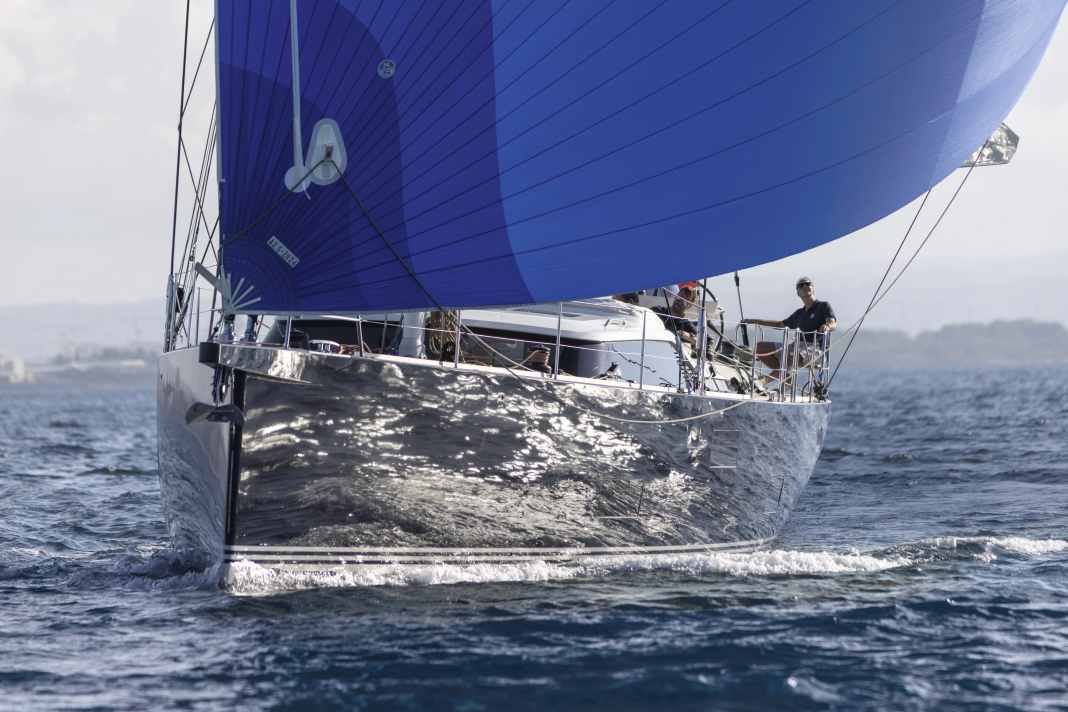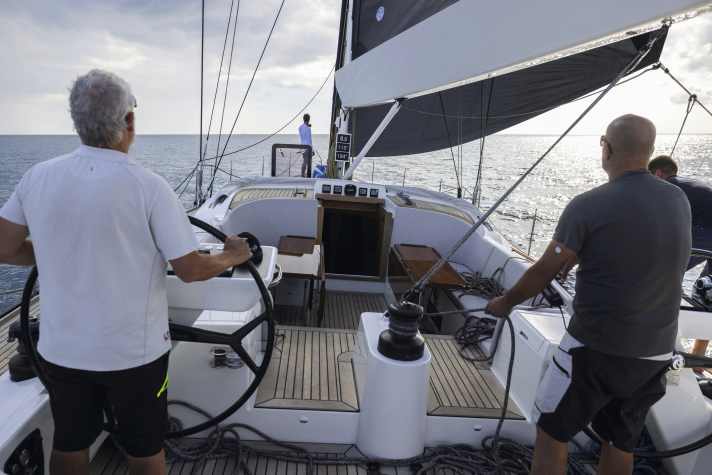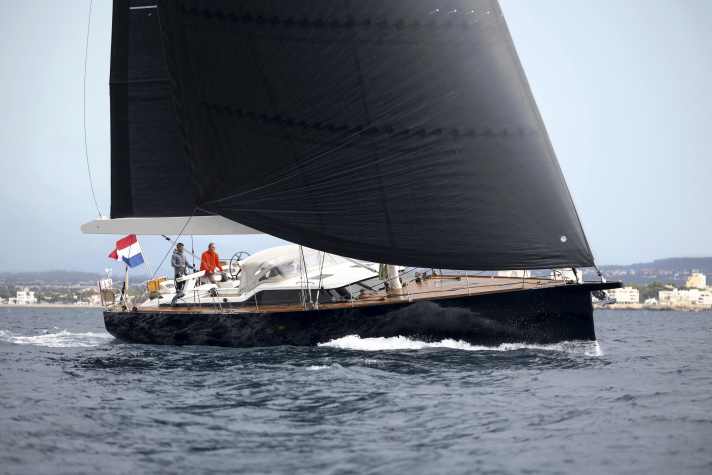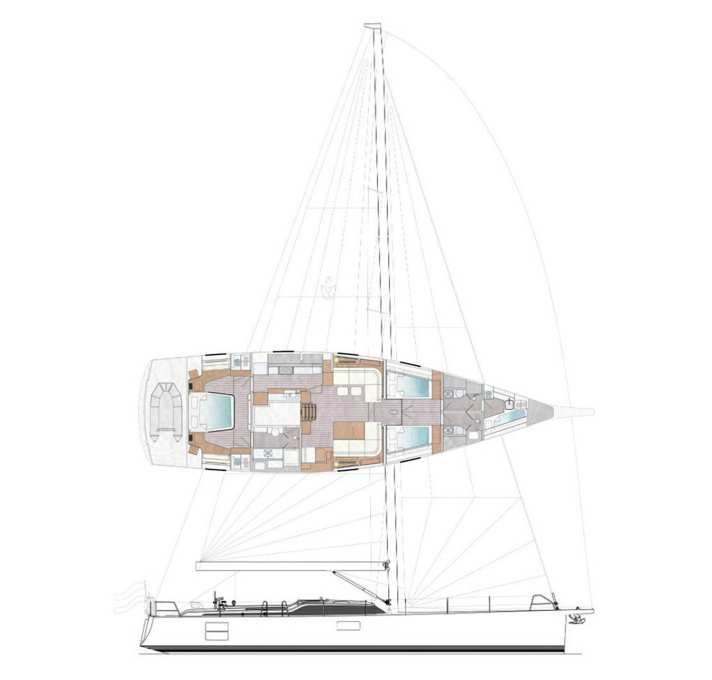Contest 63 CS: Multifunctional luxury tourer with the aura of something special
Jochen Rieker
· 19.01.2025






- Endless possibilities for customisation
- The Contest 63 CS can be controlled instinctively
- Closer to the performance segment than touring sailing
- Scandinavian cosy and Mediterranean casual
- Balance between performance and long journey
- The Contest 63 CS looks stunningly good
- The design makes the Contest 63 CS special - and quiet
- Cosy minimalism below deck
- Technical data Contest 63 CS
What turns a sequence of notes into a symphony, what turns a symphony into Beethoven's Ninth? What ennobles a piano into a Bechstein, Fazioli or Steinway? In other words, how does something that is familiar in its basic form become a piece that stands out from everything else? Or to put it another way: how do you create something truly great? That's what this is all about. But don't worry: we will no longer be practising parables, nor will we be dealing with the high art of classical music. Although we will be talking about harmony, composition and melodiousness. Because all this - and more - characterises the new Contest 63 CS.
Viewed soberly, she is also just a boat, defined by structural calculations, volume and surface distribution, characterised by lines and layout - in other words, largely an exercise in applied mathematics. However, although visually restrained, she conveys an aura of something special that sets her apart from other mass-produced yachts. In fact, you could call her downright incomparable. And you have to. Because her price is equally beyond the ordinary. It starts at 3,448,620 euros. However, it is highly unlikely that a boat will ever be ordered at this price without any extras.
Endless possibilities for customisation
If you choose the performance-optimised carbon fibre rig with North 3Di membranes, for example, with which the owner of construction number one has refined his boat, you have to add the equivalent value of a well-equipped 36-foot yacht. The hydraulic Code Zero furler, which is also recommended and which silently removes almost 300 square metres of cloth in less than 20 seconds, costs as much as a small cruiser. And that's not even mentioning the customisation options, despite the upmarket basic equipment.
The perceived infinity of the budget undoubtedly helps to make the contest exceptional. But money is not much more than a basic requirement. If it were that simple, if the price were a guarantee of excellence, the 63 CS would not be so clearly superior to its already manageable competitors. But that is exactly what it does. A closer look at the photos at the top of the gallery reveals just how much mastery it achieves. But her class is all the more apparent when you experience her live and in colour. Visitors to boot Düsseldorf can currently get an impression of this for themselves in Hall 16.
The Contest 63 CS can be controlled instinctively
We had the opportunity to experience it at sea at the end of October. During the tests for Europe's yacht of the year she was at our disposal for two days in the bay of Palma de Mallorca in very changeable conditions: from flat water with just 1 or 2 Beaufort to a storm front with heavy rain and gusts of wind force 6, in which we even quickly took her sprayhood out of the water. She overcame both extremes with an almost provocative imperturbability. It may come as no surprise that a yacht measuring a good 20 metres over all can easily cope with 22 knots of wind, as she has to be able to cope with twice as much. But it was still impressive.
Even with the performance rig, she remained calm. On deeper courses, she can parry the pressure even without a reef; downwind, you roll the main a little hydraulically into the boom - and off you go at an unchanged 8.5 knots and a pleasantly moderate angle of around 20 degrees. If you want to go rowing while the rain is coming almost horizontally, you can keep your eyes closed. This is because the Contest conveys such an unfiltered feeling for the pressure conditions on the blade that it can be steered by instinct. Only very few luxury-class yachts can achieve this.
Faster than the wind
However, she is even more impressive at the lower end of the scale, in five to eight knots of wind, where cruising boats generally struggle. The Contest 63 CS does not.
With the 63 CS, we want to offer the best possible balance between performance and long-distance cruising capability to date."
It does take a moment to get back up to speed after turning, and the turning angle - well below 90 degrees in stronger breezes - widens to almost 100 degrees. But with a speed of 5.8 to 6.5 knots, she makes you forget all about the Yanmar diesel.
The extremely precise and direct control requires a little concentration in such light wind phases, because too many or too large impulses slow you down. On the other hand, the 63 CS can be guided cleanly from one breeze line to the next. Under Code Zero, it sometimes even outperforms the true wind speed on courses with an angle of incidence of 60 to 70 degrees - a discipline for which performance cruisers and racing yachts are otherwise known.
Closer to the performance segment than touring sailing
The Contest in the configuration we sailed really does reach sporty dimensions. Even in the standard configuration, it has a sail carrying capacity of 4.6 and is therefore closer to the performance segment than the pure touring segment. However, this can be significantly increased.
Compared to the aluminium furling mast, the carbon fibre mast measures 30.30 instead of 29.00 metres above the waterline, which provides 15 square metres more sail area on the wind. Together with the textile stays, the carbon rig also saves more than 200 kilograms of top weight. As a result, and because the T-keel is 3.30 metres deep instead of 2.90 metres, the ballast can be two tonnes lighter while maintaining the same stability.
Optimised in this way, the sail carrying capacity jumps to 4.9 without fundamentally changing the character of the Contest. She is and remains a confident sea-going vessel that pampers her crew with all the comforts of a fine beach hotel. She just gets to her destination faster and is even more fun en route.

Scandinavian cosy and Mediterranean casual
Arjen Conijn, the guardian of the brand, says: "As a family-run shipyard, we are not under pressure from investors. We don't have to allow ourselves to be pushed in a direction that we don't feel comfortable with." Everything in the development process is designed for the long term, emphasises the Dutchman, who is the third generation to steer the fortunes of the company. "This allows us to preserve our roots and still keep breaking new ground."
When he took over the management of the renowned yacht building company from his father Fritz 20 years ago, Contests were primarily known for their sturdiness and flawless workmanship. They also featured technical refinements: in the 1980s, for example, the wing keels derived from the America's Cup or, from the 1990s onwards, the vacuum injection process in the manufacture of the hulls. But it was only gradually that Arjen Conijn modernised and dynamised the model range more fundamentally, without making any other compromises.
The 63 CS is perhaps the best example of the strategy, he says. "It combines the cosiness and quality of a Scandinavian cruiser with the luxury and laissez-faire of a yacht for the Mediterranean."
Balance between performance and long journey
This broad range is one of the particular strengths of the 63 CS. This is because it can be customised very well to the wishes of its owners. "The construction number one shows the maximum possible performance," says the shipyard boss. "But the standard version also sails very well. And we will soon be delivering a version for round-the-world sailing with a cutter rig and self-tacking jib."
She was to offer the "best possible balance between performance and long-distance cruising capability". Arjen Conijn wrote this into the specifications for the engineers and designers at Judel/Vrolijk & Co. If you like, she forms the golden mean between a Grand Soleil, Swan or Solaris on the one hand and an Oyster, Hallberg-Rassy or Amel on the other. An ambitious, if not bold positioning, because it forces compromises.
We paid particular attention to structure and weight distribution in the design. You can feel that when sailing."
The designers from Bremerhaven made a virtue of this. A core crew of three employees led by boss Johan Siefer dedicated all their experience and hundreds of man-hours to the project. "It's an incredibly well-developed boat. We've made a lot of improvements to the systems below deck and the structure in particular and also saved weight, for example by using moulded-in flanges that enable better, more efficient connections," says Siefer. "That's why the weight and buoyancy fit extremely precisely."
Judel/Vrolijk initially used the existing fleet and its DNA as a benchmark, particularly in terms of rigidity. "A Contest should give the crew a safe feeling and large reserves," says the studio manager. And then the question was: how can this be achieved without becoming too heavy at the same time? "It also worked out well because we have made really great progress over the years together with the shipyard," says Johan Siefer. "In the past, a contest of this size would have weighed 36 tonnes. Now we've stayed under 32 tonnes, and the performance version is even well under 30."
The Contest 63 CS looks stunningly good
And the architects achieved something else: The 63 CS looks stunningly good in a pleasantly understated way. It essentially follows the lines of the 50 CS and the 495, which celebrated their premiere in 2023, but appears better proportioned and more elongated, not least because of its size. The visually extended aft superstructure makes her more dynamic and the deckhouse is even better integrated. "People will still like looking at it in 20 or 30 years' time," says Johan Siefer.
The only thing that takes some getting used to is the positioning of the hull windows, which are on two levels and protrude twice amidships. In combination with the midnight blue paintwork of the test boat, this is hardly noticeable. On a white hull, however, it will be irritating, especially as the window areas are very large. Even vapour-coated with white dots, this cannot be completely concealed.

This is presumably why the shipyard retouched all the windows invisibly in its advertising photos and omitted some of them completely from the sail plan. However, it remains the only irritation in an otherwise flawless appearance, which also makes you forget the yacht's impressive size and high freeboard.
Plenty of space in the foredeck
Because it is designed as an owner-driver boat, the 63 CS does not have crew quarters as standard. If you want to provide one, you can order the sail locker in the bow as a multifunctional space. It can then still be used at sea as storage space for the gennaker and code zero, but can be converted into sleeping accommodation for the bosun in the harbour or at anchor using a folding berth - a sensible solution.
Judel/Vrolijk kept the foredeck in front of the mast completely free of any superstructures or fittings. It is a feast for the eyes, with a finely laid deck whose staves, set on butts, meet in the centre plank. The symmetry is broken only by the flush hatches, the edges of which are set off with wooden frames. That's the way it has to be.
Hydraulic furlers minimise the operating effort as well as the running distances of lines on deck. Halyards are retrieved and furled on electric winches next to the mast. The rest can be operated at the touch of a button from the two helm stations, which are slightly raised behind the guest cockpit. In between, the central mainsheet winch is bolted to a platform - at a safe distance from the crew and yet accessible at all times.
Three control positions per side possible
The helmsman can choose between three positions on each side: standing, sitting on the side coaming, from where you can see perfectly into the genoa's windsheets, or leaning back on the opulent seats, which offer space for two people and can also be swivelled aft. Together with the aft basket seats and folding armchairs or the stools from the saloon, you can set up a cosy aft deck get-together in no time at all.
Under this sea terrace, the Contest conceals a spacious dinghy garage, which makes it easier to launch and retrieve the dinghy using rollers and an ingenious rail system with a haul line. The bathing platform closes off the area watertight; special locking hooks additionally secure the door. And, of course, the entire garage is also sealed off from the cabin, making the boat unsinkable in the event of oar loss.
The design makes the Contest 63 CS special - and quiet
There is no need to worry about structural integrity with Contest. The fuselage is infused in one continuous mould in one piece, not in two halves as is often the case. In a second vacuum pass, the entire floor assembly including bulkheads is laminated, completely from GRP, without a steel frame, which enables a more homogeneous bond. The hull and structure are tempered for 24 hours at up to 60 degrees Celsius for curing. This also clearly sets the 63 CS apart from the majority of series yacht construction.
You can even experience the effort. When the ship gets pressurised and rushes to leeward at ten or eleven knots under gennaker, you hear nothing below deck. No whimpering from the bracing, no creaking in the fittings, no rattling of the doors in their locks. Absolutely nothing!
It is perhaps the greatest luxury that this yacht leaves you so completely alone, does not play to the fore, does not impose itself, neither acoustically nor in any other way. This is not only due to the pedantically high quality of the boat builder. The 63 CS is also an oasis of calm in terms of style.
Cosy minimalism below deck

The interior designers at Wetzels Brown in Amsterdam developed their furnishings. It can best be described as cosy minimalism. As with her hull and deck lines, the Contest is also restrained in her interior design, without compromising on quality and cosiness.
This starts with the flawless veneer appearance and continues through to the door catches invisibly inserted into the edges of the cupboards and drawers. The slotted wooden panelling on the main and aft bulkheads, which is bent at 90 degrees, is extremely subtle and of the highest quality in terms of craftsmanship. You simply have to love the boat for such perfection and sensuality.
The development of the Contest 63 CS continues
In return, it can also be forgiven for a few shortcomings: the somewhat cumbersome access to the engine room via the owner's bathroom, for example, or the lack of handholds in the saloon, which is almost five metres wide. And even for that, the shipyard will find a solution in case of doubt. After all, their motto is: "Building dreams together" - realising dreams together.
For Arjen Conijn, this means continuing to think where others stop. "We are perhaps a little crazy when it comes to detailed solutions," he says. "But that's exactly what characterises a dream yacht." The development of the Contest 63 CS is therefore not yet complete for him. He is currently having a fixed dodger drawn that will protrude over the front part of the cockpit - which is actually difficult to imagine without breaking up the sheer deck view. But the contest boss is not letting this slow him down; he is positively bubbling over with anticipation. "It will be something completely new," he promises. Even more variance for his already multifunctional luxury tourer.
Technical data Contest 63 CS

- CE design category: A
- Torso length: 19,29 m
- Total length: 20,54 m
- Waterline length: 17,85 m
- Width: 5,50 m
- Draught/alternative: 2,90/3,30 m
- Mast height above waterline: 29,00 m
- Theoretical torso speed: 10.3 kn
- Weight: 31,9 t
- Ballast/proportion: 12,5 t/39 %
- Sail area/sail carrying capacity: 212,0 m2/4,6

